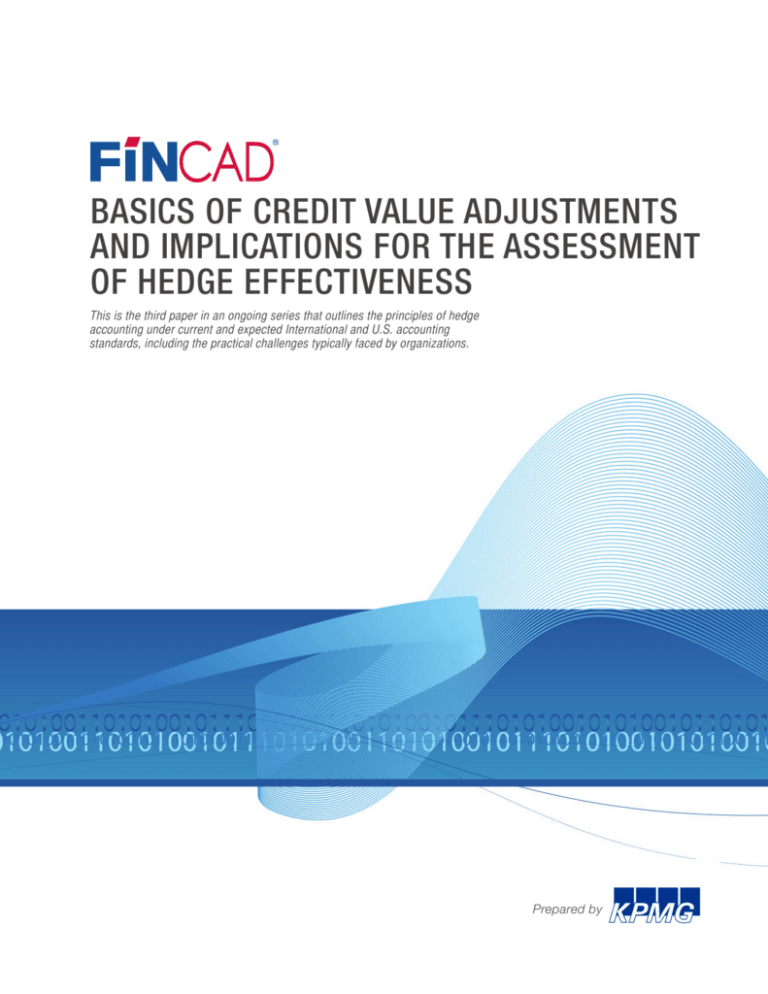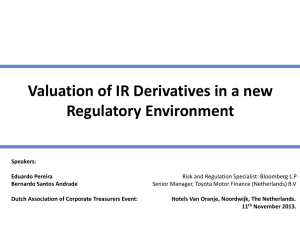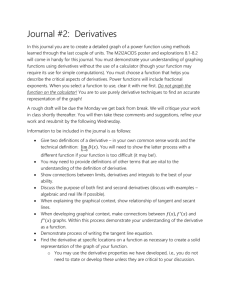
BASICS OF CREDIT VALUE ADJUSTMENTS
AND IMPLICATIONS FOR THE ASSESSMENT
OF HEDGE EFFECTIVENESS
This is the third paper in an ongoing series that outlines the principles of hedge
accounting under current and expected International and U.S. accounting
standards, including the practical challenges typically faced by organizations.
Prepared by
Basics of Credit Value Adjustments and Implications for the Assessment of Hedge Effectiveness
Under current U.S. and International accounting standards, the fair market value for Over-the-Counter
(OTC) derivatives should reflect the credit quality of the derivative instrument, which is generally captured through any applicable Credit Value Adjustment (CVA). CVA represents an adjustment made to the
value of the derivative to account for the credit risk of the counterparty to the instrument.
BRIEF HISTORY OF THE CREDIT VALUE ADJUSTMENT
The concept of default and its painful financial repercussions have been well established in history
and understood by investors. There have been many examples, including Sovereign entities such
as Russia (1998) and Argentina (2001), and Corporates such as Long Term Capital Management
(1998), WorldCom Inc. (2002), and Lehman Brothers (2008). These types of default events and the
subsequent financial fall-out lead to the evolution and development of credit risk management.
Much of the research in credit risk management was focused around the identification and
quantification of credit risk, particularly Counterparty Credit Risk (CCR) which is the exposure to loss
as a result of a counterparty failing to meet its contractual obligations due to default. While CCR was
conceptually understood, for years it was broad industry practice to value OTC derivative instruments
without considering CCR largely due to the mistaken belief that large derivative counterparties were
“too big to fail” or that it would be highly unlikely that counterparties would default. It was not until
the financial crisis in 2007/2008 that market participants realized the cold reality that no entity
was immune from default risk and began to incorporate the value of CCR and price into the cost of
derivative instruments, especially at the deal level.
CHALLENGES AROUND COUNTERPARTY CREDIT RISK
A derivative instrument is a contract between two counterparties whose price is dependent upon or
derived from one or more underlying variables. Derivatives can be classified as either a unilateral
derivative or as a bilateral derivative depending on the nature of the payoff of the instrument.
For the holder of a unilateral derivative instrument, like an investor in a purchased option position for
example, the exposure is to any loss that would occur if the counterparty were to default. The loss for
the investor would be measured as approximately the fair value of the instrument (less any recoveries)
at the time of default. The counterparty’s obligation and exposure arising from its sale of the option to
the investor remains the same whether or not the investor defaults. Any money owed to the investor
would still be owed to the investor’s estate, even in the event of default or bankruptcy by the investor.
Bilateral instruments, such as interest rate swaps and foreign exchange forward contracts, are more
complex than unilateral instruments since there is two-way or bilateral counterparty risk as both
the investor and the counterparty are exposed to each other. In the case of the swap, for example,
one counterparty is simultaneously long the receiving leg and short the paying leg, while the other
counterparty is simultaneously short the receiving leg and long the paying leg. The value of the swap
is the net value of the two legs and, in the event of default, the recovery is on the net market value of
the swap.
2
Basics of Credit Value Adjustments and Implications for the Assessment of Hedge Effectiveness
The challenge with bilateral instruments is that, at any given valuation measurement date, they may
be in either an asset or liability position or have no value at all. For this reason, each counterparty
is potentially exposed to the other. For example, Counterparty A, in an in-the-money positive asset
position today, is exposed to its Counterparty B because, in the event of default, Counterparty B would
owe it the positive market value of the swap. On the other hand, even Counterparty B, in the out-ofthe-money negative liability position, has potential credit exposure to Counterparty A. This is because
over time, that same swap may convert to an asset position. Even for a swap with zero net value,
counterparties are exposed to one another because the derivative has the potential to change to an
asset or liability position anytime.
This counterparty credit exposure or default risk may be mitigated through the netting and offset
provisions of the underlying International Swap Dealers Association (ISDA) master agreement (typically
an entity must first enter into an ISDA master agreement with a bank or dealer prior to transacting
derivative instruments), which permits offsetting negative or liability positions against positive or asset
positions with a specific counterparty in the event of default. There may also be an ISDA Credit Support
Annex (CSA) that provides for the posting of collateral to cover all or a portion of the net market value
of the position to limit the exposure.
WHAT IS A CREDIT VALUATION ADJUSTMENT?
CVA is the price of the default risk for a derivative or portfolio of derivatives with a particular
counterparty considering the effect of offsetting collateral. In other words, CVA is the price one would
pay to hedge the derivative instrument or portfolio of instruments’ specific counterparty credit risk.
CVA is calculated as the difference between the risk free value and the true risk-adjusted value. In
most cases, CVA reduces the mark-to-market value of an asset or a liability by the CVA’s amount.
CVA was introduced as an enhancement to fair value accounting around 2007/2008, coinciding with
the advent of the credit crisis. It made an entrance as a new requirement focusing on quantifying
the price of CCR just at the time when CCR and spreads attributable to those risks escalated to
unprecedented high levels. CVA has attracted much attention among derivative market participants
and their regulators alike as most major market participants already measure CVA in their accounting
statements and integrate CVA into deal pricing.
CVA VALUATION METHODOLOGIES
While CVA valuation methodologies are well advanced, they are still not standardized and may vary
amongst market participants, ranging from relatively simple to highly complex methodologies that are
driven largely by the sophistication and resources available to the market participant. Depending on
the particular market participant, CVA can be significant, particularly for large financial institutions that
are highly active in the derivative markets.
In order to determine CVA, organizations start by quantifying and measuring net counterparty credit
exposures (typically using specialized software). The next step is then to price the credit risk of those
exposures using the contractual terms and conditions of the derivative instrument or portfolio and
3
Basics of Credit Value Adjustments and Implications for the Assessment of Hedge Effectiveness
market inputs such as interest rates, foreign exchange rates, credit default swap (CDS) spreads and
other relevant variables.
Determining which CVA valuation methodology to adopt is often driven by the organization’s
sophistication, technical ability and resource constraints. The simplest approach involves calculating
the current mark-to-market value of the derivative and then repeating the calculation by adjusting the
discount rates, in a discounted cash flow framework, by the counterparty’s credit spread when the
exposure is to the counterparty (i.e. the derivative is in-the-money or an asset) or one’s own credit
spread if the counterparty is exposed to the entity (i.e. the derivative is out-of-the-money or a liability).
The difference between the two resulting present values is the CVA amount.
A more robust approach relies on a swaption type valuation approach to estimate the contingent
replacement value of the derivative using the counterparty’s respective credit spread. This approach
requires more sophisticated knowledge of derivative valuations and access to more specific market
data such as interest rate volatility surfaces.
More advanced approaches involve simulation modeling of market risk factors and risk factor
scenarios and then revaluing each derivative using, for example, thousands of simulation scenarios
by a hundred time steps. The resulting matrix of simulations by scenario and time steps is then
aggregated to generate an expected exposure profile for each netting counterparty. A collateralized
expected exposure profile is then derived by adjusting each counterparty’s expected exposure profile
to account for the receiving and posting of collateral as applicable.
Some market participants only consider CVA pertaining to their exposures to counterparties (i.e.
exposures that are at risk when counterparties default), though the majority also calculate an offsetting
Debt Valuation Adjustment (DVA), which is the counterparty’s exposure to the market participant. CVA
and DVA are then netted to calculate bilateral CVA.
COMMON CHALLENGES IN DETERMINING THE
CREDIT VALUE ADJUSTMENT
Often entities struggle with CVA due to system limitations which are tied to business needs. For
example, large financial institutions that have significant derivative portfolios actively manage CVA
through a dedicated CVA trading desk. These entities typically have advanced systems and analytics
along with the supporting infrastructure (including skilled staff) needed to run the simulations,
compute expected exposure and track and manage net collateral by counterparty that is netted against
the expected exposures.
Entities that have only a handful of derivatives would be hard-pressed to justify the same high cost
of the technology, infrastructure and people and tend to look for more cost and resource effective
alternatives such as spreadsheet models or some third-party web-based solutions. Computing CVA
using spreadsheet-based solutions is generally the least desirable solution, as they tend to be highly
unwieldy and prone to manual input error and typically still require some degree of analytical skill to
come up with the assumptions for the solution. However, for many organizations this may be the only
practical option.
4
Basics of Credit Value Adjustments and Implications for the Assessment of Hedge Effectiveness
A common challenge for all entities computing CVA (though with varying degrees) is obtaining the
necessary market data required for the calculation and, in particular, the expected exposure. At a
high level, discount curves, credit spread curves and volatility surfaces are generally all needed for
the exposure determination. The challenge lies in the fact that often this market data is not readily
available even for large financial institutions and requires some degree of judgment in coming up
with proxy data to be used to compute CVA. Name-specific or proxy CDS spreads are typically used
for credit spreads if available. Alternatively, credit spread proxy measures such as new debt issuance
spreads are commonly used where CDS spreads are not readily available. Significant judgement can
also be required in determining which proxy measures to choose, particularly if for example there are
no recent appropriate name-specific debt-issuances to reference and/or one has to then explore debt
issuance spreads for peers.
Generally, third-party market data service providers are needed to supply both the current and
historical market data required to perform the assessment analysis as conventional data sources such
as newspapers and the internet are insufficient and do not provide adequate historical data.
CREDIT VALUE ADJUSTMENT AND HEDGE ACCOUNTING
This principle of credit risk and CVA also extends to the valuation of OTC derivatives when assessing
the effectiveness of hedge relationships and measuring ineffectiveness. For example, when comparing
the change in the fair value of the derivative hedging instrument to the change in the fair value of the
hedged item (such as a fixed rate bond) in a Fair Value hedge, the valuation of the derivative should
include the applicable CVA. Similarly, when using a statistical technique, such as Regression Analysis,
to assess effectiveness, the impact of CVA should be included in the data points that represent the
derivative hedging instrument. This principle generally applies to all types of hedge relationships,
including Fair Value hedges, Cash Flow hedges and Net Investment hedges, though differences
in application exist between International and U.S. standards. Under U.S. standards, when certain
conditions relating to the probability of default of either the entity or the counterparty are met, credit
risk may be excluded from the valuation of derivatives for purposes of assessing effectiveness only.
It also follows that in principle, the method or approach selected by an entity to incorporate CVA in
the valuation of OTC derivatives should be the basis for the method or approach used when valuing
hedging derivatives for purposes of assessing and measuring effectiveness for hedge accounting.
Consequently, the challenges associated with CVA have a tendency to compound when the methods
selected for assessing effectiveness are more complex, for example, with regression-based
methodologies. The need for sufficient and appropriate expertise and resources therefore becomes
even more critical for those organizations that have a significant derivative portfolio and apply hedge
accounting extensively.
5
Basics of Credit Value Adjustments and Implications for the Assessment of Hedge Effectiveness
CONCLUSION
It is clear that capturing the dollar value of credit in the fair value of a derivative instrument or
portfolio makes sense notwithstanding that it is also a requirement under International and U.S.
accounting standards. However, doing so is somewhat of an art as well as a science. Regardless of
the methodology used to compute CVA, a certain level of expertise and management judgement is
required to ensure that CVA has been considered and appropriately applied. This is true not only for
general derivative valuation purposes, but also for the assessment and measurement of effectiveness
for those hedge relationships subject to hedge accounting. In choosing a methodology, an entity needs
to consider the availability of expertise and resources as well as how material the impact of such an
adjustment may be to the financial results.
Given the complexity and level of judgement involved, it is best to discuss CVA with your financial
advisors, accountants, systems providers, auditors and other practitioners in this field who are
conversant with market practices and current trends to determine the most appropriate approach to
apply.
The next paper in the series is titled “Upcoming Changes to Hedge Accounting under International
and U.S. Standards” and will provide further insight on the changes to hedge accounting currently
being deliberated by the International Accounting Standards Board and the U.S. Financial
Accounting Standards Board.
6
Basics of Credit Value Adjustments and Implications for the Assessment of Hedge Effectiveness
About KPMG
KPMG is a global network of professional firms providing Audit, Tax and Advisory services. KPMG
operates in 150 countries and has 138,000 people working in member firms around the world. The
independent member firms of the KPMG network are affiliated with KPMG International Cooperative
(“KPMG International”), a Swiss entity. Each KPMG firm is a legally distinct and separate entity and
describes itself as such.
About FINCAD
Founded in 1990, FINCAD provides advanced modelling solutions built on award-winning, patent
pending technology. With more than 4,000 clients in over 80 countries around the world, FINCAD
is the leading provider of financial analytics technology, enabling global market participants to make
informed hedging and investment decisions. FINCAD provides software and services supporting the
valuation, reporting and risk management of derivatives and fixed income portfolios to banks, corporate
treasuries, hedge funds, asset management firms, audit firms, and governments. FINCAD Analytics can
be accessed through Excel, MATLAB, as a Software-as-a-Service or embedded into an existing system
through software development kits. Now, over 70 FINCAD Alliance Partners embed FINCAD Analytics
within their solutions. FINCAD provides sales and client services from Dublin, Ireland, and Vancouver,
Canada.
Note: Organizations should consult the appropriate financial accounting standards prior to applying hedge accounting. These
include International Accounting Standard 39 – Financial Instruments: Recognition and Measurement, and in the U.S.,
Accounting Standards Codification 815 – Derivatives and Hedging. This article is for information purposes only and is not
intended to prescribe in detail how to meet the requirements for hedge accounting under International or U.S. accounting
principles. In addition, an entity’s accountants should be involved in any assessment regarding the application of hedge
accounting.
7
CONTACT:
Corporate Headquarters
Central City, Suite 1750
13450 102nd Avenue
Surrey, BC V3T 5X3
Canada
EMEA Sales & Client Service Center
Block 4, Blackrock Business Park
Carysfort Avenue, Blackrock
Co Dublin, Ireland
USA/Canada 1.800.304.0702
Europe 00.800.304.07020
London +44.20.7495.3334
Dublin +353.1.400.3100
Elsewhere +1.604.957.1200
Fax +1.604.957.1201
Email info@fincad.com
Copyright © 2011 FinancialCAD Corporation. All rights reserved. FinancialCAD® and FINCAD® are registered trademarks of FinancialCAD Corporation. Other trademarks are the
property of their respective holders. This is for informational purposes only. FINCAD MAKES NO WARRANTIES, EXPRESSED OR IMPLIED, IN THIS SUMMARY. Printed in Canada.








